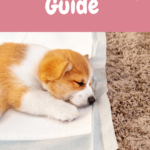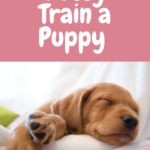So, you have brought home a new puppy?
Congratulations!
Adding a fluffy and four-legged member to the family is an exciting time. That little ball of energy will be full of love, wet kisses, snuggles, and plenty of laughter. But after a day or so, there is bound to be something else, too…
A potty accident – oops!
Cleaning up a messy accident is normal. Remember, that teeny puppy’s bladder and bowels won’t be fully developed yet. However, the sooner your puppy learns to “do their business” outside, the happier everyone will be.
Below are some helpful tips about how to potty train a puppy.
How Long Does Puppy Potty Training Take?
The first question pet parents often ask is, “When should I begin house training my puppy?”
Puppies normally take 4 – 6 months to become fully house trained. Between 12 – 16 weeks old is an ideal time to start.
According to the American Kennel Club, factors such as age, learning history, methods, consistency, and even breed can impact how quickly or slowly a puppy takes to stop having accidents inside the house. For example, a highly intelligent Border Collie might learn faster than a stubborn Dachshund who hates going outdoors in cold, rainy, and windy weather!
For dogs like this, an indoor dog potty could be beneficial.
Puppy Potty Training Essentials
Okay, you are determined to teach your puppy when and where to go potty.
Paw-some!
Below, I’ll go over a step-by-step guide to ensure both you and your pooch are successful. Before getting started, make sure you are well-prepared with the following items:
· Bite-sized treats
· Collar / leash
· Crate
· Paper towels
· Indoor potty / pee pads
How to potty train a puppy in 6 easy steps!
Step 1: Get on a Schedule
The biggest mistake people make when housetraining a puppy is being inconsistent. Therefore, be sure to get on a schedule. Dogs thrive on routine. In the initial house training stages, take a puppy out frequently.
Preventative Vet recommends scheduling potty breaks as follows:
· First thing in the morning
· After eating meals
· 5 – 10 minutes after drinking water
· Before and after playtime, naps, training sessions, etc.
So, basically all the time!
Don’t worry…as puppies grow, they learn to “hold it” for longer periods. But to start, aim for at least every 2 hours.
Step 2: Designate a Potty Area (Indoors or Outdoors)
Second, choose one spot for them to go pee/poop.
Why?
Dogs are intelligent. They dislike soiling their own surroundings and have great memories and sense of smell. In time, a puppy will come to associate one chosen spot as their bathroom.
A few good outdoor locations are:
· Patch of grass
· Tree
· Fire hydrant
· Rock
Thinking about using a doggy toilet or pee pads? For those who live in condos/apartments or with mobility issues, this may be convenient. The same rules apply for potty training. Whenever your puppy circles, whines, and act like she needs to go, quickly put her on the potty zone. Eventually, she will learn that this is her area.
Step 3: Use a Verbal Cue
Next, choose a word.
Since puppies do not speak using human language, it can be difficult to explain housebreaking concepts. However, dogs do understand verbal cues. This is a training method that teaches a dog behavior. When a puppy hears a specific word, she associates it with an action.
Common house-training cues include:
· “Go potty”
· “Do your business”
· “Pee / poop time”
· “Hurry up”
It may feel silly, but it works.
Step 4: Positive Reinforcement is a Must
Fourth, be patient and positive.
Of course, it’s frustrating to come home from work only to discover a puddle of pee on the floor. But keep in mind, your little puppy isn’t misbehaving on purpose…they just haven’t learned yet. That’s why staying positive is key.
Never physically punish, yell at, scold, or rub a puppy’s nose in their accident.
Instead, praise and reward. The second your puppy successfully goes potty where you want, feed a yummy high-value treat. Clap your hands. In a happy voice, say “Yes” or “Good girl/boy.” Offer cuddles, rubs, playtime, or a favorite toy. Now, your puppy realizes that “Hey…going potty correctly means getting all my favorite things!”
Step 5: Supervise
Let’s face it – puppies are mischievous. They are curious and will get into all sorts of trouble if pet owners aren’t careful. When it comes to house training, one of the fastest ways to teach a puppy right from wrong is also the easiest. Simply supervise them.
Watch for signs your puppy needs to go out.
For example:
· Barking
· Circling
· Pacing
· Whining
· Jumping at the door
· Licking
· Excessive sniffing
By keeping a close eye on puppy body language, you can catch them before an accident happens. Scoop them up and hurry outside or plop them down on their indoor dog potty. Can’t be home 24/7? A crate is a safe spot to confine a dog temporarily.
Step 6: Repeat, Repeat, Repeat
And lastly, practice makes perfect!
Continue building upon these skills every single day. Whether it’s a busy Monday morning or more relaxed Sunday afternoon, repeat the steps for desired potty behavior. Do not skip any days. A puppy relies on you to open the door, take them outside, and teach them what’s expected.
The more frequently they get to practice, the sooner they will be 100% housetrained.
Conclusion
Housebreaking a puppy is no easy task. But by following these steps, pet parents can help their furry friends learn the ropes quickly. Stay patient, positive and consistent and house training your puppy will be successful and rewarding.
For more great dog training tips, check out some other posts on my blog or follow me on Pinterest.



